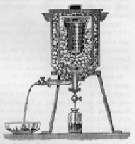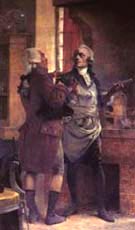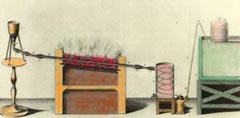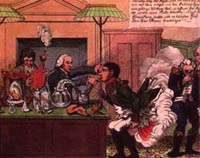Antoine Laurent Lavoisier (1743-1794)
With his colleague, the chemist Armand Séguin (1767-1835), Lavoisier studied the influence of muscular work on metabolism. A contemporary painting shows the seated Séguin as he depresses a pedal while a copper mask captures the expired air. A physician takes Séguin's pulse to determine the separate effects of exercise and food consumption. (For several hours before the experiment, Séguin had abstained from food.) Resting energy metabolism without food in a cold environment increased by 10%; it increased 50% due solely to food; 200% with exercise; and 300% by combining food intake with exercise. Lavoisier and Séguin also observed that oxygen consumption, pulse rate, and respiratory rate increased during work. Consequently, from the experiments conducted on Mr. Séguin, it results that a fasted man in a state of rest and in 26 degrees of temperature, divided into 80 parts, consumes 1210 cubic inches (24 litres) of vital air; it also results that this consumption increases in a cold environment and that the same man, fasted and resting, in 12 degrees of temperature, consumes 1344 cubic inches (27 litres) of vital air. During digestion, this process is increased to 1800 or 1900 cubic inches (38 litres). All these values are increased during movement and exercise. Mr. Séguin, fasted and carrying a weight of 15 pounds (7 kg) on a distance of 613 feet (200 metres), consumed 800 cubic inches of air, e.g. 3200 cubic inches (63 litres) per hour. Lastly, when the same exercise was done during digestion, the quantity of vital air consumed reached a value of 4600 cubic inches (91 litres). The exercise performed by Mr. Sguin involved carrying a 15 pound weight (7 kg) over a distance of 650 feet (211 metres) during 15 minutes. Lavoisier and Séguin connected two essential components of physiology--external respiration and internal combustion (heat production). This linkage proved that oxidative processes (combustion) were affected not only by food intake, but also by temperature and mechanical work. Atmospheric air provided oxygen for animal respiration. Furthermore, the "caloric" (now known as heat) was liberated in metabolism. Formerly, a vital flame" was said to burn within the heart itself; now respiration, the "substance of the animal itself," provided the necessary ingredients for combustion. In 1837, the German physiologist Heinrich Gustave Magnus (1802 -1870) first analyzed blood and corrected one flaw in Lavoisier's explanation. The Frenchman assumed that hydrogen and carbon were oxygenated in the lungs. Magnus argued that combustion must occur throughout the body, and not just in the lungs. His famous experiments showed that both carbon dioxide and oxygen existed in arterial and venous blood. Because there was more oxygen in arterial blood, Magnus deduced that the lungs could not be the primary site of combustion. In addition to studying respiration, Lavoisier conducted research in nutrition.1 Already knowing that animal tissues contained nitrogen, he investigated the composition of isolated plant fractions and concluded that combinations of carbon, hydrogen, and oxygen alone constituted sugars, gums, and starches. Noting that France's food supplies were becoming depleted, Lavoisier reported in 1778 to the Academy of Sciences on practical methods to measure wheat and flour. He wrote: It has to be accepted that other grains such as barley and oats, which do not contain gluten, are also nutritious. Starch must therefore be nutritious, but Parmentier seems to us to go too far in singling out starch as the only nutritive element in wheat. It seems obvious that gluten, with its chemical properties, is more 'animalized' and therefore eminently nutritive. Lavoisier paved the way for future studies of energy balance by recognizing for the first time that the elements involved in metabolism (carbon, hydrogen, nitrogen, and oxygen) appeared neither suddenly nor disappeared mysteriously. Rather, they reconfigured themselves in a predictable sequence during combustion. He supplied basic truths: only oxygen participates in animal respiration, and the "caloric" liberated during respiration is itself the source of the combustion. These discoveries, fundamental to modern concepts of energy balance, could not protect Lavoisier from the intolerance of his revolutionary countryman. He was beheaded by the Jacobin tribunal in 1794. Yet once more, thoughtless resistance to innovative science temporarily delayed the triumph of truth. © Frank I. Katch, William D. McArdle, Victor L. Katch. 1998. *A collection of Lavoisier's instruments are in the Conservatoire
des Arts et Metiers in Paris. One of the balances could weigh 600 mg
to ± 5 mg, and another was accurate to the nearest ± 0.1 mg. References 1. Carpenter, K. J.(1994). Protein and energy: a study of changing ideas in nutrition. Cambridge University Press, London. Additional Resources http://www.kaiwan.com/~lucknow/horus/guide/ec109.htmlDuveen, D. I., and Klickstein, H. S. (1954). A Bibliography of the Works of Antoine Laurent Lavoisier, 1743-1794. London: W. Dawson & Sons, and E. Weil. Guerlac, H. (1973). "Lavoisier," Dictionary of Scientific Biography, Vol. VIII, Bibliography, pp. 87-91.
Edited by Mary Ann Wallace. Webmastered
by Jason Nugent. Last updated 12 Jan 1998. |
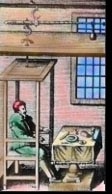
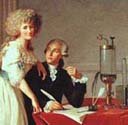 Lavoisier
and his wife, Marie-Anne Paulze (1758-1836), who shared Lavoisier's
passion for chemistry. She took painting lessons from the famous
French artist David who painted this commissioned work for 7,000
pounds in 1788, an extraordinary sum at that time. The Metropolitan
Museum of Art, New York, encapsulates the essence of the chemistry
aspect of the painting. "The laboratory instruments share this
quietly shimmering quality. The distillation flask on the right
has the transparency and brilliance of the finest glass, while
the test tubes on the table have the flat, dense look of thick
glass; each instrument has it's own distinct texture and reflections
play off their surfaces with a marvelous lightness. They are
in the picture to bear witness to the Lavoisiers' experiments
and their sole object is to serve as symbols and emblems. They
are, above all, still life masterpieces."
Lavoisier
and his wife, Marie-Anne Paulze (1758-1836), who shared Lavoisier's
passion for chemistry. She took painting lessons from the famous
French artist David who painted this commissioned work for 7,000
pounds in 1788, an extraordinary sum at that time. The Metropolitan
Museum of Art, New York, encapsulates the essence of the chemistry
aspect of the painting. "The laboratory instruments share this
quietly shimmering quality. The distillation flask on the right
has the transparency and brilliance of the finest glass, while
the test tubes on the table have the flat, dense look of thick
glass; each instrument has it's own distinct texture and reflections
play off their surfaces with a marvelous lightness. They are
in the picture to bear witness to the Lavoisiers' experiments
and their sole object is to serve as symbols and emblems. They
are, above all, still life masterpieces." 